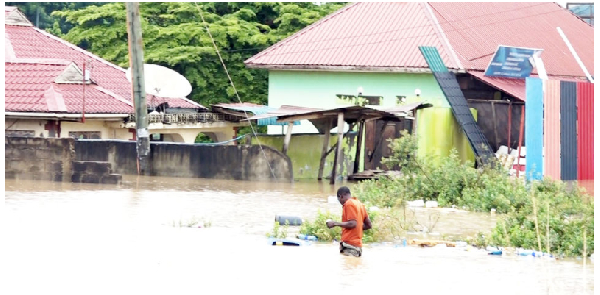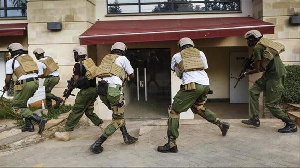155 people die in Tanzania as heavy El-nino rains wreak havoc

Heavy rains and flooding are wreaking havoc in East Africa, having already claimed dozens of lives and displaced thousands in Tanzania and Kenya.
Prime Minister Kassim Majaliwa told Parliament in Dodoma on Thursday that at least 155 people have been killed and 236 others injured in Tanzania, adding that rising global temperatures are to blame for the current El Nino rains.
“Heavy El Nino rains, accompanied by strong winds, floods and landslides, have had a devastating impact in various parts of the country. This includes loss of life and destruction of crops, homes, people’s property and infrastructure such as roads, bridges and railways,” he said.
More than 51,000 households and 200,000 people have been affected and at least 10,000 houses damaged.
An increase in heavy rainfall was observed from January to April and weather forecasts indicate that torrential rains will continue into May.
Mr Majaliwa said affected areas include Rufiji and Kibiti in Coast Region; Malinyi, Mlimba, Kilosa, Morogoro Municipality and Ifakara (Morogoro); Ilala, Kinondoni, Ubungo, Kigamboni and Temeke (Dar es Salaam); Same, Hai and Moshi (Kilimanjaro); Mbarali, Kyela and Mbeya City (Mbeya) and Kigoma Ujiji Municipality and Kakonko in Kigoma Region.
Others are Iringa Rural (Iringa); Tabora Municipality (Tabora); Bahi (Dodoma); Lindi Municipality, Kilwa, Liwale and Nachingwea (Lindi); Masasi (Mtwara); Arusha City, Monduli and Karatu (Arusha); Muleba and Bukoba Municipality (Kagera); Shinyanga Municipality (Shinyanga); Geita Town, Nyangh’wale and Chato (Geita); Mbozi and Momba (Songwe); Nkasi, Sumbawanga and Kalambo (Rukwa) and Hanang’ in Manyara Region.
Mr Majaliwa said the government is well prepared and taking appropriate measures to prevent and mitigate the severity of disasters while also normalising the situation in the affected areas.
“It should be noted that in preparing for these rains, the government developed the National Emergency Plan for Preventing and Responding to El Nino Effects from September 2023 to June 2024, along with emergency plans in 14 high-risk regions expected to be affected by heavy rains driven by El Nino.
“The severe impact we are witnessing is primarily due to environmental degradation caused by indiscriminate deforestation for energy use and unsustainable farming practices involving tree-cutting and slash-and-burn agriculture as a means of preparing land for cultivation. Another factor is unregulated livestock grazing exceeding the capacity of grazing lands, resulting in land degradation and destruction of protected areas, including water sources,” Mr Majaliwa said.
He added that the government plans to build dams that would reserve floodwaters to be used for irrigation, fishing and livestock feeding as part of a long-term solution to the problem.
Government directives
The government has directed its institutions to continue being committed to disaster preparedness and response by collaborating with other stakeholders in implementing tasks outlined in the El-Nino Preparedness and Response Plan, as well as sectoral plans to prevent and mitigate adverse effects.
Mr Majaliwa said the government has also directed district and regional disaster management committees to continue taking appropriate measures, including advising people in their areas of jurisdiction and providing timely assistance when disasters occur.
People have been urged to follow weather forecast reports issued by the Tanzania Meteorological Authority and heed advice given by leaders in their areas, including moving to safe areas and planting recommended crops.
Since environmental degradation has had a significant impact due to climate change, the government has urged leaders at all levels to collaborate with citizens and curb environmental degradation in their areas, the Prime Minister told Parliament.
The government directed that schools in affected areas be closed and owners of private schools establish a mechanism to compensate for missed lessons so that the current term’s calendar is completed as scheduled.
Mr Majaliwa added that school owners and school bus drivers must ensure that they are satisfied with the routes they take to ensure the safety of learners using the vehicles.
Parents, guardians and society should also ensure the safety of pupils when going to and from school at all times, especially during the rainy season.
The government has also directed the Tanzania National Roads Agency (Tanroads), Rural and Urban Roads Agency (Tarura) and railway firms (Tazara and TRC) to assess the roads and railway lines affected by floods in various areas and put in place plans for quick repairs.
The Police Force, through the Traffic Police Unit, should continue advising motorists and other road users during current rainy season, Mr Majaliwa said.
The government has directed disaster committees at the village, district and regional levels to oversee the distribution of relief aid provided to flood victims and ensure that the assistance reaches the intended beneficiaries as soon as possible.
Government leaders from the village level upwards should mobilise and educate residents living in low-lying areas to move to safer areas to prevent disasters during floods and ensure that safe areas are designated for residents relocating from risky areas.
Mr Majaliwa said urban planning authorities nationwide should oversee municipal urban planning and control unplanned construction that obstructs waterways. Additionally, plans for proper land use should be put in place in all rural areas and properly supervised.
The Health ministry has been directed to provide community health education to prevent disease outbreaks and ensure access to treatment.
Rains pound Nairobi
In Kenya, the Daily Nation reported on Thursday that at least six people were swept away by raging floods after torrential rains pounded Nairobi on Tuesday night.
Among the dead include a woman, who after rescuing her child, was prompted to go back and pick something, but drowned after a wall collapsed around Mabatini 4A area in Mathare.
Athi-Sabaki-Galana River broke its banks. Downstream, two more bodies were lying waiting for police officers to pick them as the people who recovered the bodies confirmed that one had earlier been picked up by the police.
In Kasarani, two people, including a bodaboda rider, were swept away after River Majimazuri burst its banks. Six others were yet to be located, according to Nairobi Governor Johnson Sakaja.
Locals were left stranded after floods submerged Namanga Road on Wednesday.
He said more than 60,000 people, mostly women and children, have been severely affected following the devastating flash floods that hit the city.
“The search is on to locate six others who have been reported missing,” Mr Sakaja said.
In the last three days, more than a dozen people in Nairobi have lost their lives in floods while thousands have been affected.
Arusha-Moshi road links cut
In Arusha, ongoing rains have disrupted communication along the Arusha-Moshi highway at several points due to water covering and flooding the area near Malula in King’ori.
Water started rising early on Thursday, causing vehicles and their occupants to be stranded for over four hours.
“Since midnight, we’ve been here, but until now we couldn’t go to school. We ask the government to improve this infrastructure,” said a stranded student of Malula Secondary School, Hussein Mohamed.
Kenyan President William Ruto directed the formation of a multi-agency response team to deal with raging floods in the country.
At the same time, opposition leader Raila Odinga asked the government to declare the current floods situation a national disaster.
Five killed in Moshi
In Moshi, Kilimanjaro Region, five people were reported to have died on Thursday, including three children from one family, while several others have been injured, following heavy rains in various areas of the region.
In addition to the fatalities, several houses have collapsed, and others have been surrounded by water, leading to several households being displaced, with livestock, food, and other property being swept away by the floods in the wards of Mji Mpya, Msaranga, Kimochi, Kahe, and Mabogini in the district.
The floods, which occurred overnight, are due to the Rau River overflowing and breaking its banks, causing water to spill into residential areas and farmland, resulting in extensive property damage and loss of life.
Speaking during rescue operations in the affected areas, the Acting Commander of the Fire and Rescue Department, Kilimanjaro Region, Jeremiah Mkomagi, said the floods were caused by heavy rains ongoing in the region, resulting in significant disasters and many houses being surrounded by water.
“Three deaths, including children, occurred in the Kimochi ward after the house they were living in collapsed. Four people from that family were injured, and we have rushed them to Mawenzi Hospital. However, we have recovered two other bodies from the Msaranga area and the Rau forest, which were swept away by the water,” he said.
Motorists’ agony in Iringa
In Iringa Region, drivers lamented that they were sleeping in their vehicles after they got bogged down, prompting Kilolo MP Justine Nyamoga to request the Rural Roads Agency (Tarura) to consider using concrete to repair rough spots to ensure the road remains passable.
Due to the ongoing rains, road conditions have worsened in some areas, causing vehicles to get stuck.
The road damage caused Mr Nyamoga’s visit to the Ukwega and Kimara wards in Kilolo District to be postponed after encountering a stranded vehicle on the damaged road while the rain continued to pour. She was speaking during a tour of areas that currently face road challenges due to the rains in her constituency.
Source: thecitizen.co.tz





